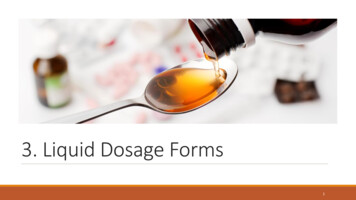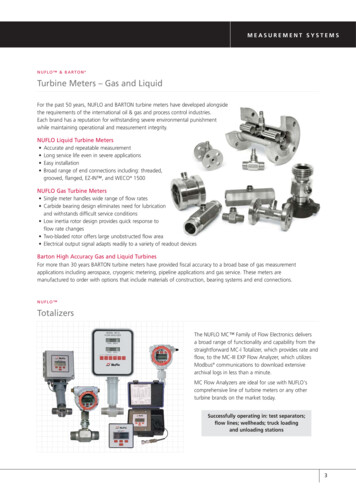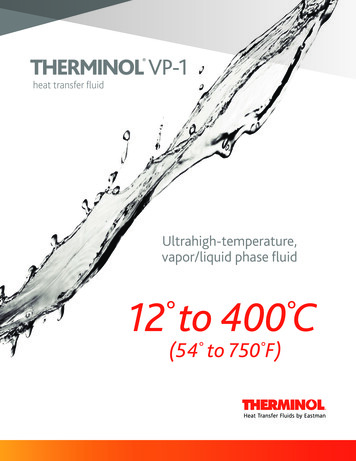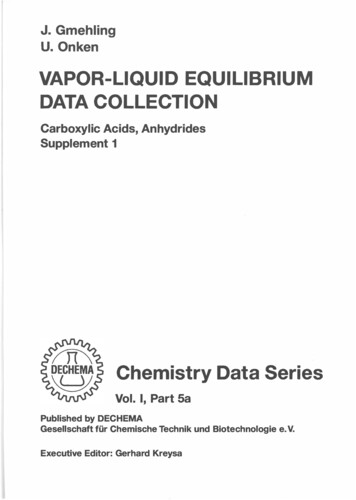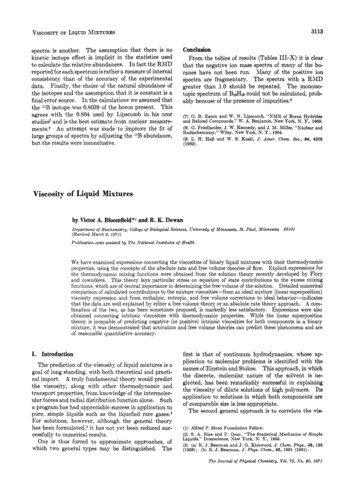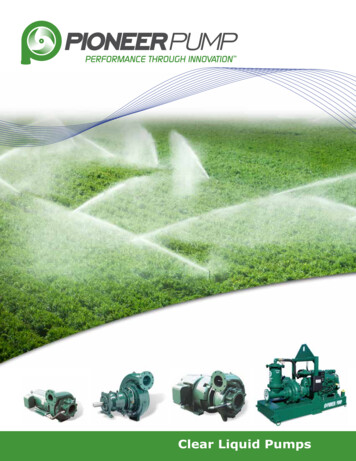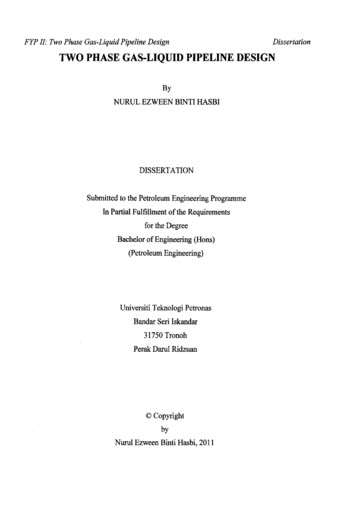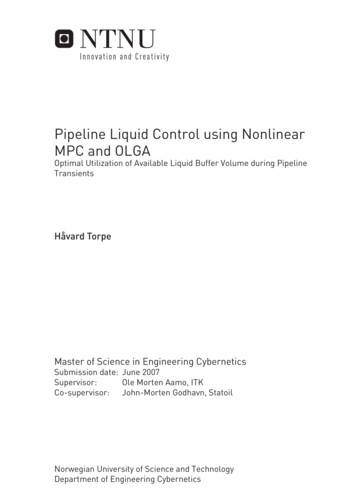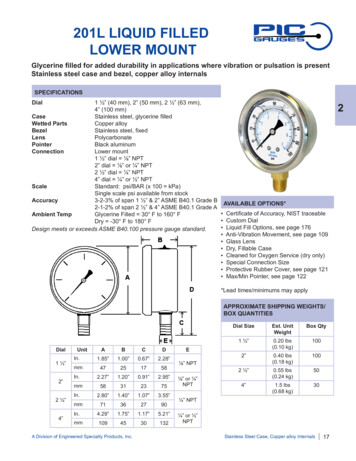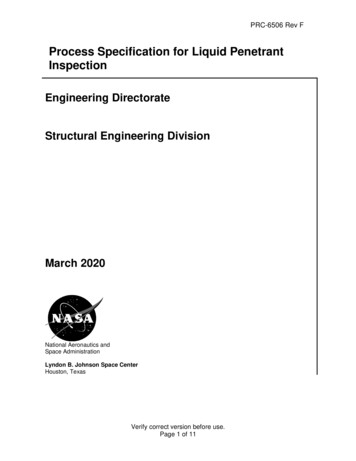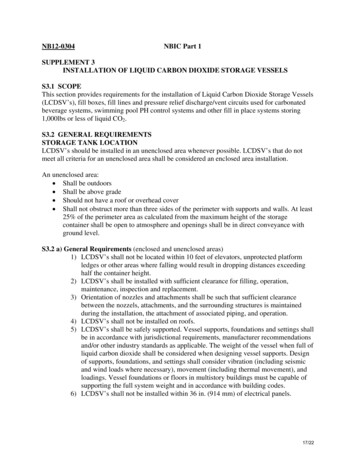
Transcription
Liquid UV Curable CyclohexanedimethanolDiacrylate MonomersDr. Kiran K. Baikerikar, Dr. Michael L. Tulchinsky, & Dr. John ArgyropoulosThe Dow Chemical Company, Core R&DMidland, Michigan 48674, USAAbstractUNOXOL Diol is a liquid cycloaliphatic diol based on a unique composition of (cis,trans)1,3/1,4 cyclohexanedimethanol, and is a starting material for synthesis of acrylate monomers for use inultraviolet (UV) and electron beam (EB) cured coatings, inks, and adhesives. Diacrylate monomersprepared from this unique diol and containing less than 15 wt.% trans-1,4-cyclohexanedimethanoldiacrylate, are liquid at room temperature and readily soluble in other acrylate monomers and oligomers(in contrast to diacrylates prepared from 1,4-cyclohexanedimethanol, which are solid). Moreimportantly, UV cured coatings based on (cis,trans)-1,3/1,4 cyclohexanedimethanol diacrylates showsuperior hardness, scratch resistance, abrasion resistance, and chemical resistance, compared to commondiacrylate monomers used in the UV coating industry, such as tripropylene glycol diacrylate, hexanedioldiacrylate, dipropylene glycol diacrylate, and propoxylated neopentyl glycol diacrylate. Thus, this newmonomer appears to be a promising material for enhancing the performance of radiation cured coatings,inks, and adhesives. This paper will summarize the synthesis of novel liquid cyclohexanedimethanoldiacrylates, as well as, the performance properties of the corresponding UV cured coatings.IntroductionAcrylate monomers are low molecular weight (100 MW 500 amu) reactive diluents, whichare used primarily to reduce the viscosity of radiation curable formulations, but also to impart additionalbenefits, such as improved adhesion, reactivity, hardness, or flexibility. Due to their good balance ofproperties, the most commonly used aliphatic diacrylate monomers in UV curable coatings aretripropylene glycol diacrylate (TPGDA), hexanediol diacrylate (HDDA), dipropylene glycol diacrylate(DPGDA), and propoxylated neopentyl glycol diacrylate (2PO NPGDA). However, aliphaticdiacrylates with improved hardness, scratch resistance, abrasion resistance, chemical resistance, andweatherability are still desired for the next generation of UV curable coatings, andcyclohexanedimethanol diacrylates (CHDMDA) are a class of monomers that can potentially offer thesebenefits, due to the presence of the cyclohexyl ring.Overview of Commercially Available Acrylates Prepared from 1,4-CyclohexanedimethanolCommercially available cyclohexanedimethanol diacrylates are prepared from 1,4cyclohexanedimethanol, which is a solid diol at room temperature. 1,4-Cyclohexanedimethanoldiacrylate is touted for its abrasion resistance, hardness, and chemical resistance. However, thismonomer is a solid at room temperature and insoluble in most acrylates, thus significantly limiting itsuse in UV/EB curable formulations.1To alleviate this problem, the solid diol (1,4-cyclohexanedimethanol) can be alkoxylated witheither ethylene oxide or propylene oxide and then reacted with acrylic acid to form alkoxylatedcyclohexanedimethanol diacrylates. These products are commercially available liquids at roomtemperature and are readily soluble in acrylates used in UV curable formulations. According to supplier
literature, these monomers exhibit enhanced scratch resistance, impact strength, and abrasion resistancecompared with industry standard monomers, such as TPGDA and HDDA.2 However, alkoxylation leadsto increased molecular weight (MW) and less defined structures of the monomers, since the length ofside chains is difficult to control. Thus, the specific MW of these monomers (ratio of MW to thenumber of reactive functional groups) is higher than that of the parent 1,4-cyclohexanedimethanoldiacrylate, resulting in reduced crosslink density and lower hardness of the cured coating. As a result,the objective of the present work was to synthesize a diacrylate monomer that retains or improves uponthe valuable properties of 1,4-cyclohexanedimethanol diacrylate, but is liquid at room temperature andfree of alkoxylation.Recently, a new, liquid cycloaliphatic diol consisting of a unique composition of (cis, trans)-1,3cyclohexanedimethanol and (cis, trans)-1,4-cyclohexanedimethanol has been commercialized.3 Incontrast to 1,4-cyclohexanedimethanol, UNOXOL Diol (henceforth referred to as 1,3/1,4 CHDM) is aliquid, and can be used to synthesize liquid cyclohexanedimethanol diacrylate monomers.HOHOOH s-1,4cyclohexanedimethanolFigure 1: Chemical structure of UNOXOL Diol (1,3/1,4 CHDM), which is a liquid cycloaliphatic diol mixture.This paper will summarize the synthesis of novel liquid (cis,trans)-1,3/1,4 cyclohexanedimethanoldiacrylates (henceforth, referred to as 1,3/1,4 CHDMDA), as well as, the performance properties of thecorresponding UV cured coatings.ExperimentalGas Chromatography (GC) AnalysisDiol samples were analyzed on a HP 5890 gas chromatograph with an FID using a DB-1 column(60m x 0.32mm x 1.0µm), helium as a carrier gas at 1.5 ml/min constant flow, 300 C injector anddetector temperatures, and split ratio 50:1. The oven program was as follows: 80 C for 5 min, 5 C/minfor 36 min, and 260 C for 12 min.Diacrylate samples were analyzed on a HP 6890 gas chromatograph with an FID using a ZB-1column (60m x 0.32mm x 1.0µm), helium as a carrier gas at 1.5 ml/min constant flow, 300 C injectorand detector temperatures, and split ratio 100:1. The oven program was as follows: 50 C for 2 minutes,10 C/min for 25 min, and 300 C for 6 minutes.Preparation of Cyclohexanedimethanol Diacrylates from Standard 1,3/1,4 CHDM (Sample #1)A mixture of (cis, trans) 1,3/1,4-cyclohexanedimethanol (100 g; 0.694 mol of UNOXOL Diol)was mixed with toluene (400 ml) and di(isopropyl)ethylamine (252 g; 1.95 mol) and was cooled to 0 Cusing an ice bath. Acryloyl chloride (153 g; 1.7 mol) in toluene (200 ml) was added slowly over 1 hourwhile stirring. After the addition, the mixture was stirred for one more hour and then warmed to roomtemperature. GC analysis revealed that the reaction was complete. The mixture was filtered and thesolid residue was washed with toluene (200 ml). The combined filtrate was washed with water (2 x 300ml), 0.1 M citric acid (5 x 300 ml), saturated NaHCO3 (300 ml), saturated NaCl (300 ml), and then driedover MgSO4. Toluene was removed using a rotovap, and the residue was additionally kept in oil pumpvacuum ( 0.7 mm Hg) at 60 C for 2 hours. The resulting crude product (180 g) was chromatographed
on silica gel using hexane-ethyl acetate (from 40:1 to 10:1). The pure fractions were combined, 4methoxyphenol (MEHQ) polymerization inhibitor (100 ppm) in hexane was added, the solvent wasevaporated, and the residue was kept in oil pump vacuum to get the constant weight. The pure material(138 g, 79% yield) was characterized by GPC and GC. 13C NMR spectrum (CDCl3, δ, ppm): 20.37,24.84, 25.20, 28.06, 28.73, 29.26, 30.22, 31.82, 32.58, 34.37, 36.60, 36.96 (cyclohexane ring); 67.10,67.38, 69.27, 69.29 (CH2O); 128.41, 128.42, 130.45, 130.49 (C C), 166.13, 166.15, 166.16, 166.17(C O). GC/MS: 180 (M - CH2 CHCOOH), 108 (M - 2CH2 CHCOOH), 93, 79, 67, 55. The sampleseparated into solid and liquid phases at room temperature and the GC scans of both of these phases areshown in Figure 2 below. The isomer composition of each phase, as well as, the overall reaction schemeare highlighted in the Results and Discussion section (see Table 6 and Figure 6).LiquidDetector Response(mV)400600Sample # 1200Solid2 4 .02 4 .52 5 .02 5 .52 6 .02 6 .52 7 .02 7 .5E lu tio n T im e ( m in )Figure 2: GC scans for the liquid and solid phases of Sample #1 (upper GC: liquid sample; lower GC: solid sample).The isomer elution sequence is cis-1,3-; trans-1,3-; cis-1,4-; trans-1,4- as determined by NMR. The trans-1,4diacrylate is the minor isomer in the liquid sample and the major isomer in the solid sample.High Efficiency Fractional Distillation of 1,3/1,4 CHDM1,3/1,4 CHDM was distilled at 123-131 C and 0.3-0.4 mm Hg using a 50 cm Oldershaw column:Table 1: Scale-up of 1,3-/1,4-Cyclohexanedimethanol Fractional Distillation (2,536 g)Initial and Distilled Amount in GramsCis-1,3Trans-1,4Trans-1,3Cis-1,4Diol Fractions(% Initial Material)isomer (%)isomer (%)isomer (%)isomer (%)Starting Material2,536 (100)25.330.729.914.1Fraction 1B325 (12.8)29.033.824.712.5Fraction 2B551 (21.7)28.332.726.212.9Fraction 3B1,078 (42.5)26.430.728.414.6Fraction 4B281 (11.1)23.627.332.716.4Fraction 5B129 (5.1)21.524.636.018.0Fraction 6B65 (2.3)19.322.737.820.2Fraction 7B65 (2.3)16.618.343.721.4Residue40 (1.6)13.114.548.224.1
Sample # 2DetectorResponse(mV)20406080Preparation of Liquid 1,3-/1,4-Cyclohexanedimethanol Diacrylate (Sample #2)Sample #2 was prepared by acrylating a late distillation cut (Table 1, Fraction 7B) containing65 g of 1,3/1,4-cyclohexanedimethanol. The cloudy acrylated sample was filtered to give 56 g of clearliquid cyclohexanedimethanol diacrylate with the composition presented in Table 6 (Sample #2) in theResults and Discussion section. GC scans for this liquid sample are depicted in Figure 3.23.223.423.623.824.024.224.424.624.8Elution Time(min)Figure 3: GC scans for liquid cyclohexanedimethanol diacrylate (Sample #2). The isomer elution sequence is the sameas in Figure 2.Figure 4 shows the difference in appearance between liquid 1,3/1,4 CHDMDA (Sample #2) and thecurrent commercially available solid product: 1,4 cyclohexanedimethanol diacrylate. The liquiddiacrylate (containing less than 15% of the trans-1,4-isomer) remains completely liquid when stored atroom temperature, and does not show any visible signs of crystallization after 1 year of storage.1,3/1,4CHDMDAFigure 4: Appearance of liquid 1,3/1,4 CHDMDA (left) vs. solid 1,4 cyclohexanedimethanol diacrylate (right).Coating MaterialsThe synthesized liquid (cis,trans)-1,3/1,4 cyclohexanedimethanol diacrylate (1,3/1,4 CHDMDA)was then compared to commonly used diacrylate monomers, as well as, alkoxylatedcyclohexanedimethanol diacrylates. Three alkoxylated cyclohexanedimethanol diacrylate monomerswere evaluated: (i) 3 mole ethoxylated cyclohexanedimethanol diacrylate (3EO CHDMDA), (ii) 5 moleethoxylated cyclohexanedimethanol diacrylate (5EO CHDMDA), and (iii) 5 mole propoxylatedcyclohexanedimethanol diacrylate (5PO CHDMDA). Diacrylate monomers were used as received fromthe supplier (Sartomer) and without further purification. Chemical structures of the monomers underevaluation are shown in Figure 5.In addition, the performance of the monomers was evaluated in conjunction with an aliphaticurethane diacrylate (AUDA) oligomer (EBECRYL 8402, Cytec). To initiate polymerization, thephotoinitiator, 1-hydroxycyclohexyl phenyl ketone (IRGACURE 184, Ciba), was used.
OOOOOOOOO1,6 hexanediol diacrylate; HDDA (MW 226.27 g/mol)Odipropylene glycol diacrylate;DPGDA (MW 242.25 g/mol)OOOOOOOOnOmm n 2propoxylated (2 mol) neopentyl glycol diacrylate;2PO NPGDA (MW 328.41 g/mol)tripropylene glycol diacrylate; TPGDA(MW 300.35 g/mol)OOOYOOmOOnOYethoxylated (Y H) or propoxylated (Y CH3)cyclohexanedimethanol diacrylate; EO or PO CHDMDAOOOOcis/trans 1,3/1,4-cyclohexanedimethanol diacrylates;1,3/1,4 CHDMDA (MW 252.31 g/mol)Figure 5: Chemical structures of aliphatic diacrylate monomers used in UV coatings.UV Curable Coating FormulationsCoating formulations ( 15 grams) were prepared by mixing the acrylates with photoinitiator in aFlackTek SpeedMixer (Model DAC 150 FV-K, FlackTek Inc) using a Max 60 Cup and mixing for 5minutes at 3000 RPM. Specific compositions are shown in Tables 2 and 3.Table 2: Composition of UV Curable Coatings applied on Glass and PolycarbonateComponentWt.% of ComponentDiacrylate monomer95.24%1-hydroxycyclohexyl phenyl ketone photoinitiator4.76%TOTAL 100.00%Table 3: Composition of UV Curable Coatings with Aliphatic Urethane DiacrylateOligomer and Diacrylate Monomer applied on PolycarbonateComponentWt.% of ComponentAliphatic urethane diacrylate (AUDA) oligomer47.62%Diacrylate monomer47.62%1-hydroxycyclohexyl phenyl ketone photoinitiator4.76%TOTAL 100.00%Coating Application and UV CuringCoating formulations were applied on glass and polycarbonate substrates using wire wound rods.Coatings were applied on glass substrates using a #8 wire wound rod to yield 10 micron (dry film
thickness) coatings, whereas coatings were applied on polycarbonate substrates using a #20 wire woundrod to yield 35-40 micron coatings. Coatings were UV cured in air using a microwave-powered FusionUV System (Model DRS-10/12QNH with VPS/I600 lamp system) at a conveyor speed of 10 feet/minuteand a 600 W/inch Fusion H electrodeless bulb (100% lamp power). The corresponding irradiance andenergy density were measured with a Power Puck radiometer from EIT, Inc. and are shown in Table 4:Table 4: Irradiance and Energy Density used for UV CuringUV AUV BUV C(320 – 390 nm)(280 – 320 nm)(250 – 260 nm)Irradiance (mW/cm2)13471252154Energy Density (mJ/cm2)13811274151UV V(395 – 445 nm)900914Property TestingViscosityViscosities of the liquid materials were measured with a Brookfield DV III Rheometerequipped with the Small Sample Adapter (#31 spindle and SC4-35Y sample chamber; 10.5 ml samplevolume). Viscosities were measured at 25 C and 20 RPM.Appearance – Initial HazeTo characterize the appearance of the coatings, the initial haze of the coatings was measured witha haze meter (Haze-Gard Plus, Byk-Gardner), in accordance with ASTM D1003 and D1044. All initialhaze data were acquired in total transmittance mode (between 400 and 700 nm) with a port hole size of 1inch. For coatings on transparent substrates, initial haze values less than 1.0% are desired.Abrasion Resistance TestAll abrasion tests were performed on coatings applied on polycarbonate using a Taber Abraser(Model 5150, Taber Industries, Inc.) equipped with CS-10F abrasive wheels at a total load of 1000gra
High Efficiency Fractional Distillation of 1,3/1,4 CHDM 1,3/1,4 CHDM was distilled at 123-131 C and 0.3-0.4 mm Hg using a 50 cm Oldershaw column: Table 1: Scale-up of 1,3-/1,4-Cyclohexanedimethanol Fractional Distillation (2,536 g) Initial and Distilled Diol Fractions Amount in Grams (% Initial Material) Cis-1,3 isomer (%) Trans-1,4
